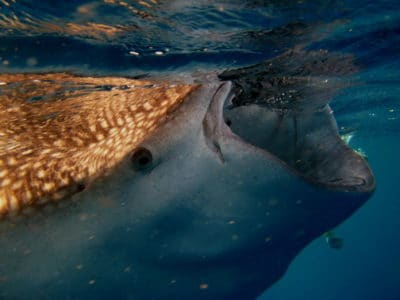After another spectacular day exploring the Farasan Banks, I was once again enamored by the wonders of the Red Sea and the rich diversity of life that abounds on the reefs and in surrounding waters. We completed two spectacular wall dives and were preparing for our third dive, a midshelf reef located the north, when we had a sudden change of plans. The groundtruthing team spotted a whale shark four miles south of the Golden Shadow. In anticipation of the chance to see the largest living fish, and a unanimous vote to abort our dive, we headed south. The group was suited up, with mask and fins in place and cameras in hand, long before we received coordinates for the site. Chances were slim that the shark would still be in the area, but it was an opportunity not to be missed, and there was no turning back.
As we reached the site, about 30 km offshore in dark blue water that was 300-400 meters deep, we saw a large dorsal fin slowly extend out of the water. It slowly approached our boat and the team eagerly entered the water. The water was a bit gloomy, and full of plankton, which made me a bit nervous and unsure of what we would encounter.
The majestic animal approached the group, swimming slowly. Unlike other sharks, these are not efficient swimmers. They typically move at speeds of only about 5 km or 3 miles per hour. Finning hard, I was able to swim alongside – although this animal was much larger than me, it was a relatively small whale shark.
I guessed it was about 4 meters in length and much less than half the size of a full grown individual. The whale shark was mostly grey, with a white belly and a checkerboard pattern of dark spots. I got a close up look at its small eye, located on the front of its flattened head – It was almost as if this magnificent animal acknowledged my presence.

Scooping up and filtering the plankton-rich waters to feed.
I was amazed at the large size of its gills, five pairs that extended across its lateral surface nearly the full width of its body. As I kept swimming with it, it opened its giant mouth, which was lined with small teeth – more than 300 rows of them. Interestingly, these are not used for feeding. The whale shark is one of the three living shark species that is a filter feeder. It was swimming close to the surface of the water scooping up mouthfuls of plankton rich water. Upon closing its mouth, the shark simultaneously opened its gill flaps, forcing the water out and trapping jellyfish, small krill and phytoplankton in the process. Apparently, whale sharks can filter out particles that are only 2-3 mm in diameter.
A little later, we encountered a second and third whale shark. These were slightly larger than the first animal, also slowly circling the area as they continued to feed.
We spent the next hour swimming with these grandiose creatures. One swam alongside me, and then dived out of site, only to approach the surface once again. This must have been a highly productive area because the whale sharks were not alone; we also saw a manta ray, which is also a filter feeder.

Our whale shark swimming away to the ocean depths.
This was truly a once in a lifetime experience; never had I been so close to such a graceful and gentle animal. It’s hard to believe that these beautiful sharks are targeted by commercial fisheries and it’s sad to know that populations in many areas are in trouble. Fortunately, they are still quite common in the Red Sea, and in the Farasan Banks we had the opportunity to swim with them today.


